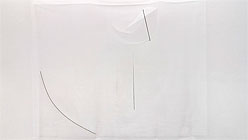Mitzi Pederson is an artist who has long dealt in the aesthetics of invisibility. Her contribution to the 2008 Whitney Biennial consisted of a piece of iridescent orange cellophane draped from a highly perched, bowing wood panel, and the majority of the pieces in her 2009 Ratio 3 show were comprised of some combination of wood, sand and string. In addition to those aforementioned, Pederson’s practice has drawn on everyday materials like charcoal, vellum, paper, glue, tape, plastic, silver leaf, and aluminum. She has perfected a willowy, barely-there quality; the longer you stare at her work, the more it seems to disappear.
In her fourth solo show at Ratio 3 Gallery in San Francisco, Mitzi Pederson: Ciphers, the artist has managed to create a series of works that are even more pared down in material and effect. Each piece uses silk tulle — some swathe’s toned in pink and black and others left pale, some stretched to canvas bars and others tacked directly into the wall — as their principal infrastructure. If you aren’t familiar, tulle is a relatively inexpensive fabric often used to embellish formal gowns (google ‘Emma Watson + tulle’ for a better idea). I can’t imagine a more contrary use for the material than in Pederson’s reductive application.

Mitzi Pederson, Seasons (Blue), 2012.
The majority of her pieces in the show, mostly listed as Untitled, consist of one layer of the sheer fabric, usually shorn into rectangles and pinned at their highest point directly to the wall. While a few larger works, such as Seasons (Blue), are unadorned, most others have trace, strategic cuts and folds, and thin pieces of painted, darkly glittering wood, stitched to, and hanging from, their diaphanous surfaces. Other pieces, such as Stardreamer are a bit more ornamented (all things considered); in that work, Pederson has run several, light strokes of blue acrylic medium on the tulle’s surface. To my surprise, they felt at once more of a challenge and a relief, but the pieces were otherwise so similar in approach that the disparity was a welcome one.

Mitzi Pederson, Stardreamer, 2012.
This brings me to my lone critique of Ciphers, and Pederson’s work: its homogeneity. Artists must necessarily maintain a consistent practice, but they need to also grow and evolve. Too often, after successful critical and commercial reception, artists continue to reiterate the same visual strategies instead of taking new chances in their work. Pederson’s work is as sophisticated as it is beautiful, but I am rarely surprised by it.


